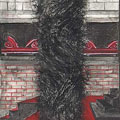
Gerard Beringer
A sample of Gerard Beringer’s art works can be found in a publication following an exhibition at the Museum of Pontoise (November 2009 to March 2010) Collection Gilles Deves by Editions du Valhermeil ISBN 978-2-35467-053-5; and in his chef d’oeuvre, the 240 art works which illuminate The First Day of Sodom by the Marquis de Sade to be published by Tambar in 2013, illustrated in this accompanying Gallery above.
An exhibition of Gerard Beringer’s Portraits et Autoportraits (Oeuvres de la collection Gilles Deves) is on display at the Galerie d’Exposition du Theatre de Privas (France) from 22 September 2012 to 10 November 2012.
Gerard Beringer was brought up by his loving parents in a tiny country village in the Ardeche region of France. His father worked in a factory near the outskirts of Lyons, his mother an Italian immigrant, kept home. He was a sickly boy and spent almost all his days at home drawing and painting. The village lay close to a mediaeval fort, the Chateau de Thorrenc, which became the subject for many of his childhood drawings, and which today evokes his vision of the Marquis de Sade’s Chateau de Silling in The First Day of Sodom. On the few occasions when he managed to attend the local village school, he did not join the other children in class. The local teacher recognised that he was only interested in art, and left him alone to decorate the school buildings with whatever he fancied. As a result of this informal education, he found himself without any qualifications and was apprenticed to become a house painter as his sole means for earning a living. His life changed dramatically when an art lover stumbled across his drawings and took him to the Ecole des Beaux Arts at Valence, where he was given a scholarship and the means to continue his passion for art. His final graduation project was a series of drawings to illustrate Le Mort by Georges Bataille, which the examiners considered to be a work of such extraordinary accomplishment that they arranged for him to be sent to Paris to pursue his career. His early years in Paris were supported by art dealers and patrons who gave him free lodging, often in the homes of their mistresses, while he eked out his living with what he could sell. The quality of his art was appreciated early with a series of exhibitions in Paris, Marseille, Toulouse, and Tours, culminating in three major solo showings at the prestigious Galerie Berggruen in Paris and international renown with exhibitions in Amsterdam, Brussels, Copenhagen, Geneva, Madrid, Montreal, Oslo and Rome. He now lives in his own studio near the Place Pigalle in Paris.










